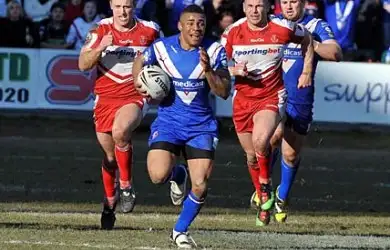Creativity the key to Super League

Wrestling, tackling and defences have stolen a lot of the headlines so far this season, but to win games you need to score tries. So making sure you have creative players in key positions is a must for any rugby league team.
The way the game is played has changed a lot in the past 15 years, with more and more coaches recognising that you can’t build a team around a single play-maker anymore, and expect to be successful, no matter how genius a player he is. It used to be that the scrum half was the fulcrum of the side, and every attacking play revolved around him. Now we are increasingly seeing creative players filling each and every one of the key central positions – full back, stand off, scrum half, hooker and loose forward.
Of course, not every team has an inventive player in all of those positions, but most of the top teams in Super League feature either a creative full-back or hooker or loose forward, in addition to their half-back duos.
League leaders Wigan still rely heavily on their half backs to spark their attack into life, especially reigning Young Player of the Year, Sam Tomkins. His kicking game and elusive running are well used near the opponents try line, but Wigan have tried to encourage creativity too in the other key positions. Tommy Leuluai and Paul Deacon have been able half-back partners for Tomkins this season, but Leuluai’s vision and effective passing have also been used in the dummy half role on a regular basis. In addition to which, Sean O’Loughlin has been encouraged to exert more of an influence in attack – usually from the loose forward position – as have full-backs Cameron Phelps and Amos Roberts. Wigan’s creativity though, has been stifled in recent weeks with the combined losses of Leuluai, Deacon and Roberts to injury.
Second place Warrington have some of the most enviable creative options in Super League this season, especially in the half-back positions. Regular play-makers Richie Myler and Lee Briers have been well assisted by Simon Grix, who has stepped into Briers’ shoes to great effect during his seven games out with injury. Warrington have also experimented with Chris Bridge (normally a centre or stand off) at loose forward on several occasions, as they look to boost their creative options. And those options look to be further increased next season, with the likely arrival of the gifted full-back Brett Hodgson from Huddersfield.
St Helens have struggled with players being forced to play out of position for much of the season, due in no small part to the absence of Paul Wellens. Wellens’ full-back position has been filled by Leon Pryce, leaving a gap at stand-off. And with several players used in that position, they seem lack a recognised creative back-up.
However, a reliance on Kyle Eastmond – playing his first full season as the team’s first choice number seven – has proved sufficient so far. His supporting cast, including the likes of James Roby, Scott Moore and Jon Wilkin have provided adequate assistance, but no doubt Saints are still relieved to now have Wellens back, and players returning to their more natural positions.
Fourth placed Huddersfield have shown their intent on having as much inventiveness as possible in their team, with the recent acquisition of Danny Brough from Wakefield. The arrival of Brough – an out-and-out scrum-half – has allowed the Giants to move recognised play-maker Luke Robinson in to the key role of hooker. That move, combined with the guile of Brett Hodgson at full-back, and the in-form Kevin Brown at stand-off, now give Huddersfield more attacking options than most other Super League teams. Coach Nathan Brown will be hoping that this will now elevate them from a predominantly defensive outfit, to a real attacking force.
Of the other ten Super League teams, Leeds have perhaps been most affected by an injury to an influential player. Kevin Sinfield’s four game absence was marked by just one win, with no-body else seemingly capable of providing his creative spark. Leeds’ inability to cope with the loss of Sinfield is in stark contrast to how Warrington have managed without their talisman, Lee Briers.
Bradford, like St Helens have struggled to find the right combination of players in the key positions. Without a recognised creative full-back, coach Steve McNamara has taken to playing usual stand-off Brett Kearney at full-back, with the versatile Paul Sykes switching to six, alongside their main play-maker, Matt Orford at seven. And the move has paid off, with the Bulls winning four out of their last five matches, with the other game a 20-all draw against Leeds.
The importance of having creative players in the central positions is perhaps most evident when looking at the season’s statistics so far. The top seven players with the most try assists to their names, all play in the loose forward, stand off or scrum half positions. In fact, when you add in the full-back and hooker positions too, 22 of the top 25 try creators regularly occupy one of those key roles.
Most notable are those who play outside of the traditional play-making positions of stand-off and scrum-half. Sean O’Loughlin, a loose forward, tops the list with 12 assists in 12 appearances; beating his tally of 11 for the whole of last season already. Keiron Cunningham, a hooker, is only four behind, with eight assists (in joint eighth place); Brett Hodgson, a full-back, also has eight to his name; and stand-in full-backs Amos Roberts and Leon Pryce have seven and six respectively. Proof, if proof were needed that coaches are increasingly looking not just to their half-backs, but to players in other key positions for that valuable creative spark.